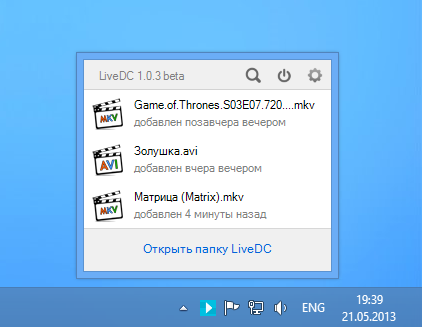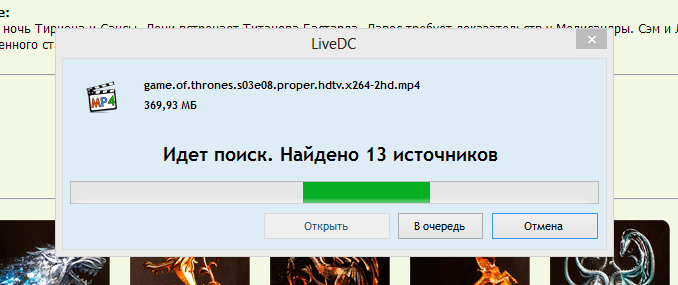LiveDC - Quick access to p2p files
Today there are a large number of DC-clients for all tastes. However, they are all endowed with a significant drawback: you need to wait until the downloaded file is fully loaded. And if you want to watch a movie or a new episode of your favorite series in high quality, then even with an Internet speed of 100 Mbit / s, you will have to wait for quite a while. But you want something now!

Suppose we want to see a movie. Usually, for this you need to download it. But after all for viewing we need only a small specific section of the file. So why wait until it is fully loaded ?!
')
This is how LiveDC came into being. I tried to remove all the excess from the process of consumption of p2p content. The client will choose where to download the file and provide access to it as soon as possible.
The client creates a virtual "hard disk" in the system on which files from the p2p network are located. This allows you to provide access to the file until the end of its loading into the system. Applications and the system see a regular file, and all requests to it pass through the DC client. If the data is already loaded, it is sent in response, otherwise the client sets the high priority of the requested segment and waits until it is loaded.
File type does not matter. For example, you can mount an image and start installing a program or game while it is still loading.
Dokan library is responsible for working with virtual disk. It provides a driver for the file system, as well as a shell for using it from under .NET.
The DC functionality is represented by my SharpDC library. About her, if it is interesting, I can tell in the following articles.
The program is designed to work with the catalogs of magnet links. After launch, the program will intercept links of the magnet type: from the browser.
As such, the client interface is virtually absent.
The main window appears when you click on the icon in the notification area.

Here are the 3 most recently added files. In addition, you can go to the settings or open a search on the hub. Yes, DropBox users will notice something familiar.
LiveDC provides the ability to search by hubs. Currently, files cannot be added to the share; however, the client will distribute the downloaded files.
When running, LiveDC starts processing magnet links and creates a virtual disk (L: \), where you can find all the files ever opened through the client. The last three files become visible when you click on the program icon in the notification area.
After clicking on the magnet link, a window appears:

The client searches all available hubs and tries to establish connections to start the download. Once the download starts, the file can be opened.
The program is written in C # in Visual Studio 2012.
Development of the program is conducted as a hobby. At the moment the client is in the status of "beta". Since the program uses the driver, when an error occurs, BSOD is not excluded. Save important documents before use.
Download (1.9 MB)
Everything that I wanted to do "for myself" is implemented in the program. It is very interesting to hear your opinion about the product. Is it worth developing LiveDC further and loading its functions?

Relevance
Suppose we want to see a movie. Usually, for this you need to download it. But after all for viewing we need only a small specific section of the file. So why wait until it is fully loaded ?!
')
This is how LiveDC came into being. I tried to remove all the excess from the process of consumption of p2p content. The client will choose where to download the file and provide access to it as soon as possible.
Work mechanism
The client creates a virtual "hard disk" in the system on which files from the p2p network are located. This allows you to provide access to the file until the end of its loading into the system. Applications and the system see a regular file, and all requests to it pass through the DC client. If the data is already loaded, it is sent in response, otherwise the client sets the high priority of the requested segment and waits until it is loaded.
File type does not matter. For example, you can mount an image and start installing a program or game while it is still loading.
Dokan library is responsible for working with virtual disk. It provides a driver for the file system, as well as a shell for using it from under .NET.
The DC functionality is represented by my SharpDC library. About her, if it is interesting, I can tell in the following articles.
Interface
The program is designed to work with the catalogs of magnet links. After launch, the program will intercept links of the magnet type: from the browser.
As such, the client interface is virtually absent.
The main window appears when you click on the icon in the notification area.

Here are the 3 most recently added files. In addition, you can go to the settings or open a search on the hub. Yes, DropBox users will notice something familiar.
LiveDC provides the ability to search by hubs. Currently, files cannot be added to the share; however, the client will distribute the downloaded files.
When running, LiveDC starts processing magnet links and creates a virtual disk (L: \), where you can find all the files ever opened through the client. The last three files become visible when you click on the program icon in the notification area.
After clicking on the magnet link, a window appears:

The client searches all available hubs and tries to establish connections to start the download. Once the download starts, the file can be opened.
As a conclusion
The program is written in C # in Visual Studio 2012.
Development of the program is conducted as a hobby. At the moment the client is in the status of "beta". Since the program uses the driver, when an error occurs, BSOD is not excluded. Save important documents before use.
Download (1.9 MB)
Everything that I wanted to do "for myself" is implemented in the program. It is very interesting to hear your opinion about the product. Is it worth developing LiveDC further and loading its functions?
Source: https://habr.com/ru/post/181906/
All Articles